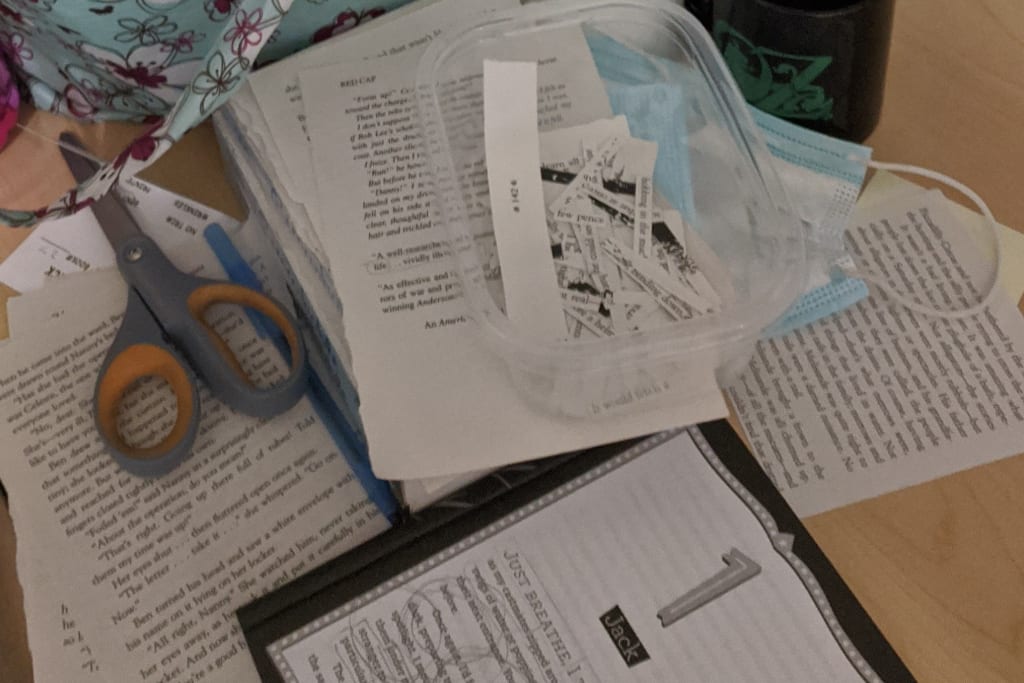And Then I Cut Them Up, Part 1
Giving Books New Life

This story recounts the birth of an art project. Or rebirth in a sense, like a phoenix, if you consider how I used the created pages of books – tragically destined for a landfill – as the starting point for many new creations.
But first, you should understand the context of how this came to be…
I used to get paid to destroy books.
Or more accurately, I was hired to sell them. And therefore also unpack them, organize them, display and rearrange them, tag them with price guns, and eventually rip off their covers.
Now don’t judge me so quickly! I never thought I would be capable of harming a book. They hold such immeasurable value. Their knowledge and delight, their history, the feeling of being absorbed in another perspective, another time and place, or even another world of the imagination. I love books. I want to make books. They are a treasure. I get queasy at the very thought of their unnatural demise.
Once, years ago, I found a booth in an art fair where the pictures from children’s books had been turned into jewelry. I was both elated and mortified. What a great way to show your love of literature, and have a unique piece of fashion, all at the same time. From a creative standpoint, what a brilliant idea for using the materials at hand, and inventing a niche product. They were stylishly put together. But what about those books? Where did they come from? Could they have been enjoyed, and instead were destroyed? Sliced to bits, never to be read again. I couldn’t help but purchase one necklace of Alice In Wonderland, yet with a lingering guilt. Who knows if they were researched ahead of time, to ensure rare copies weren’t being sacrificed, all for the sake of profits. Was I supporting the murder of books?
My passion for reading and creating stories led me to work at a bookstore. As an artist, I had researched and continued to grow in areas like portfolio development, networking, and how to pitch to publishers. Being in a retail environment gave me a different view of the industry, placing books into the customers’ hands, and all the logistics thereof. It was there that I first saw the mass grave of books.
Our books went through a cycle. They would premiere in hardcover, sell a lot, sales go down and they get sent back to publishers, re-released in paperback, sell up and down and returned, eventually the hardcovers get sent back to us again with a 20% off sticker for the sales section… and so forth. With one or two exceptions.
At the big bookstore, it was the romance novels. Flimsy, too cheaply made to even be worth the shipping, they were treated like magazines. When they stopped selling, they’d be removed from the shelf. Their covers were stripped and sent back, as evidence of their former existence and current demise. The rest was waste.
Back then, I only witnessed the remains of this carnage. An unkempt pile of books on the floor in the back room, their first page exposed, revealing a paragraph meant to hook you in. With morbid curiosity, I’d poke at them, catching the first phrases of a fleeting scene, having a moment of inspiration as I imagined the rest of the book. Giggling at the overly dramatic language, telling myself it was just fluff anyway. Or perhaps the way you might laugh nervously in a sad moment. I was, after all, at a book funeral. I grew accustomed to it, I suppose.
Until, several years later, I worked in a children’s bookstore. Having become friendly with the co-worker who handled shipping, returns, and such matters behind the scenes, it was subtle but I began to notice the signs here too. Sure enough, we also had our cycle, and the books that missed it.
This time, it was the cheap chapter books that came in long-running series, or popular paperbacks that were bought in bulk but sales had finally slowed. It was sadder for me to see this happen, perhaps because these were the kinds of books I wanted to make. But I understood the business side of things. Eventually though, he showed me the simple process, and the responsibility fell on me too.
Tear, put the cover here, put the rest in recycling. Over and over.
I knew it needed to happen, but there must be something I could do, some way to salvage a value out of them. The moments of inspiration came back, from glancing at a drawing, catching a few words. At least I was gleaning the seeds of ideas, taking mental notes for spin-off sketches. I started siphoning off pages with striped paper, thinking I could fold them into flowers. If I ever looked up how to do that.
The question was stewing in my mind. How could I do my job as instructed, but also save and use some part of them? Thinking back, it may have been because I “got a desk”. One of the first to return to work last spring, I was packaging online orders and handling these kinds of backstock tasks. I had started tearing pages out, with words and sentences I particularly liked.
And then, I took the scissors to them.
About the Creator
Ellen Stedfeld
Visual artist & writer immersed in drawing, illustration, and creative experiments @EllesaurArts.com
Community arts in NYC/LIC Queens and online, NaNoWriMo "The Ellesaur"
Love participating in challenges to motivate new work!






Comments
There are no comments for this story
Be the first to respond and start the conversation.